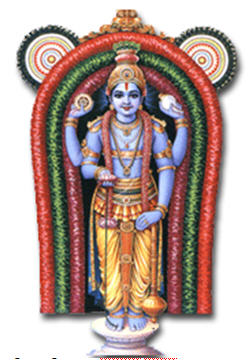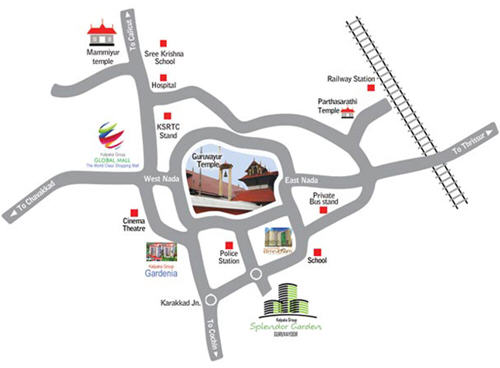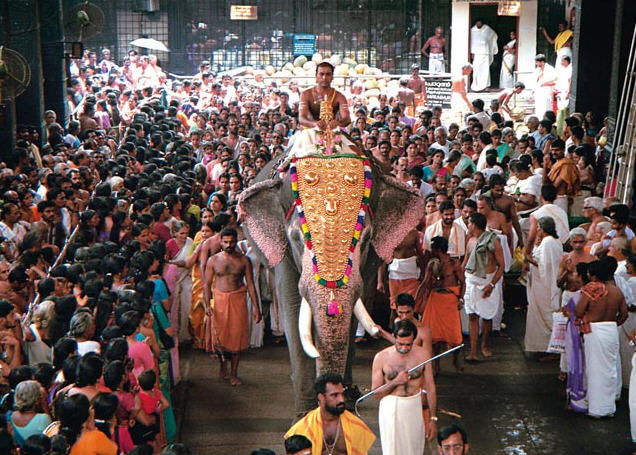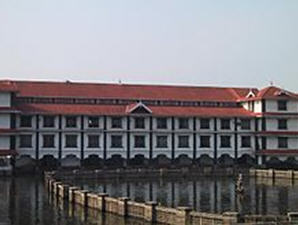
The “Narada Purana” contains the story connected to origin of Guruvayur shrine : King Janamejaya, in order to avenge the death of his father Parikshit, which was brought by the Naga performed the “Sarpayajna” (snake sacrifice) in which thousands of innocent reptiles perished. As a result of their curse that befell him, he was afflicted with leprosy, which left him in utter despair. Sensing this, sage Dattatreya appeared before him with a remedy i.e., to beg for mercy of Lord Krishna at Guruvayur.
Janamejaya asked about the glorious of the lord and the whereabouts of the place. In Reply, the sage recounted how at the beginning of the Padma Kalpa, Lord Vishnu gave this deity to Brahma,who could execute his task of Creation by worshipping the lord in his deity form.
At the beginning of the Varaha Kalpa, the childless couple, Sutapa & Prishni prayed in earnest to Brahma for the gift of a son. Brahma gave them this deity assuring them of their wish if they worshipped the deity with sincere devotion. This they did with excellence, so much so that the Lord Vishnu himself appeared before them. As a boon, they prayed Him three times, for a son. He pacified them that he himself would be born to them as their son in three successive births. Moreover, they would also have the good fortune of worshipping the divine deity in all the three births and So, in the first life, to Sutapa and Prishni was born as their son, Prisnigarbha. In their second life, to Kasyapa & Aditi, the couple worshipped the same deity and got their son Vaman. In their third and most auspicious life as Vasudeva and Devaki, Sri Krishna was born to them.
After slaying Kamsa , Krishna moved to Dwaraka where he built a temple for his parents to worship this deity. When the time come of him to end his earthly pastimes, Lord Krishna entrusted his devoted friend Uddhava, to take good care of the Deity. At the end of his earthly sojourn, Krishna prophesied to his friend and devotee, Uddhava that the island of Dwaraka, which had been his stronghold, would be swept away by the sea, seven days after he would leave. He instructed him to rescue the precious Deity of Vishnu which his parents had worshipped, and hand it over to Brihaspati, the guru of the gods who would come to him.
After seven days, the island submerged in the sea as foretold by Lord Krishna. Uddhava went sadly to the seashore and saw the Deity bobbing up and down on the waves far out in the sea. He begged the wind god Vayu to bring it closer to him. The wind wafted it gently to the shore and Uddhava picked it up lovingly and cradled it in his arms. As he was wondering how to contact the guru of the gods, he found that Brihaspati himself was walking towards him. Uddhava told him the whole story of how Lord Krishna had instructed him and Brihaspati who knew everything agreed to take it and install it at some special place. He was sure that he would be given further instructions.
Now Brihaspati asked Vayu, the wind god to transport him through the air so that they could choose a perfect spot for the installation. Carrying the precious Deity in his hands, Brihaspati was carried across the sub-continent of India till they came almost to the sea shore to the spot where the present town of Guruvayoor now stands. Looking down Brihaspati saw a beautiful lake filled with lotuses on the banks of which Shiva and Parvati were dancing. He was charmed by the sight and he requested Vayu to float him down. For some time he stood spell-bound by the dancing couple. When they had finished their divine dance,he prostrated to them and begged Shiva to tell him of a perfect spot to install the Deity of Vishnu. Shiva said that this was indeed the ideal place. He told him to build the temple right there at one end of the lake where he and Parvati had been dancing. He magnanimously said that he himself would take up residence at the other end of the lake which was known as Rudrathirta. During the course of time the lake dried up little by little and now only the temple tank adjoining the Guruvayoor temple remains to tell the tale of this ancient lake. The temple of Mammiyoor to which Shiva shifted still exists. It is for this reason that a visit to Guruvayur is considered incomplete without visiting mammiyoor temple. Guru and Vayu installed the deity in the temple built by Viswakarma, the architect of the God. As Guru and Vayu together founded the temple, the place came to be known as Guruvayurpur in accordance with Shiva’s wish. The name was later shortened to Guruvayur.
The word Guruvayur has special connotations. It is made up of two words “guru” and “vayu”. Guru means preceptor and vayu is wind. The Deity was installed by Brihaspati, the guru of the gods and Vayu, the god of wind and hence came to be known as Guru-vayoor!
Moved by this story, Janamejaya proceeded to Guruvayur temple where he observed austere devotion for four months. In the night he would go to Mammiyur and bow before Shiva. One night while asleep he felt the lord’s healing touch over his body and his pain was no more! He returned to his kingdom elated singing praises for the Lord.
According to the story about the temple, this Deity is over 5,000 years old.
The Deity of Sri Krishna is made of the rare stone patalaan janam He has four arms carrying a conch, disc, mace and lotus.The upper right hand holding chakra, lower right hand holding lotus, upper left hand holding shankha and lower left hand holding gada.
The temple schedule begins at 3 am with nirmalayamdarshan (viewing the Deity), followed by abhisheka. Temple is closed between 1 and 4:30 pm.
Bilvamangla Thakur, the author of Sri Krishna Karnamrita, frequently visited the temple.
Tulabharam is a common vow in which devotees donate to the Deity a quantity of an article equal in weight to their own bodies.
The temple worship is done by Nambudri Brahmins, who are expected to live within the temple precincts during their term of worship.



